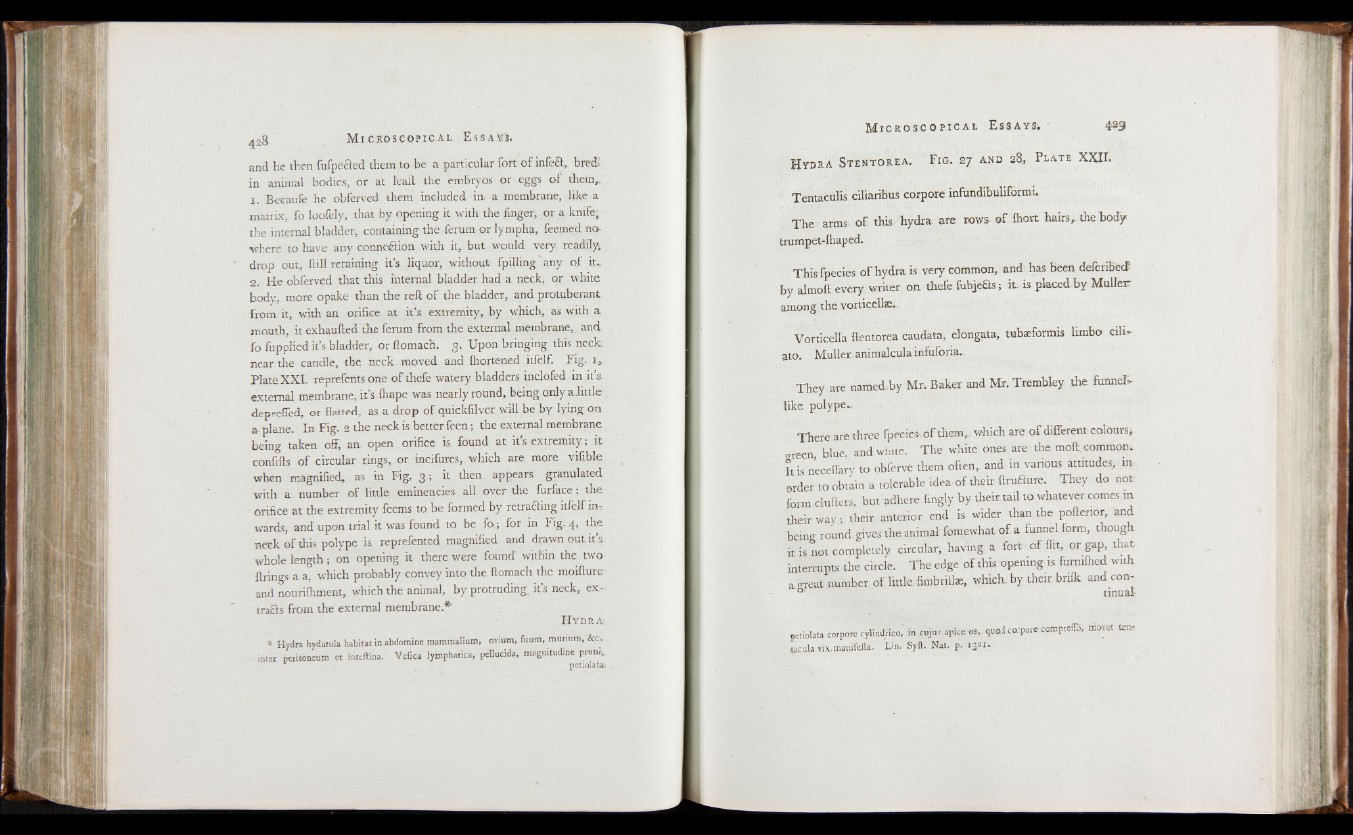
and he then fufpefled them to be a particular fort of infeft, bredi
in animal bodies, or at 1'eaft the embryos or eggs o f them».
1. Becaufe he obferved them included in, a membrane, like a
matrix, lb loofely, that by opening it with the finger, or a knife,
the internal bladder, containing the ferum or lympha, feemed no,
■ where to have any conne&ion with it, but would very readily-
drop out, ftill retaining it’s liquor, without fpilling any of it.
2. He obferved that this internal bladder had a neck, or white
body, more opake than the reft of the bladder,, and protuberant
from it, with an orifice at it’s extremity, by which, as with a
mouth, it exhaufted the ferum from the external membrane, and
fo lupplied it’s bladder, or ftomach. 3. Upon bringing this neck
near the candle, the neck moved and fhortened itfelf. Fig. 1,
Plate XXI. reprefents one o f thefe watery bladders inclofed in it’s,
external membrane, it s.Ihape was nearly round, being only a .little
depreffed, or flatted, as a drop of quickfilver will be by lying on
a plane. In Fig. 2 the neck is better feen; the external membrane
being taken off, an open orifice is found at it s extremity; it
confifts o f circular rings, or incifures,. which are more vifible
when magnified, as in Fig. 3 ; it then, appears granulated
with a number of little eminencies all over the furface; the
orifice at the extremity feems to be formed by retracing itfelf inwards,
and upon trial it was found to be fo ; for in Fig. 4, the
neck of this polype is reprefented magnified and drawn out it’s
whole length; on opening it there were found" within the two
firings a a, which probably convey into the ftomach the moifture
and nourifhment, which the animal, by protruding, it’s neck, ex-
tracts from the external membrane.*’
Hydra;
* Hydra hy.datula habitat in abdomine mammalian), ovium, funm, murium, &c.
iatet peritoneum et inteftiha. Vefica lymphatica, pellucida, magnitudine prunt;
r petiolatat
423
H y d r a St en to r e a . F ig . 2 7 a n d 28, P l a t e X X I I .
Tentaculis ciliaribus corpore infundibuliformi.
The arms, o f this hydra are rows- o f Ihort hairs, the body
trumpet-fhaped.
This fpecies ofhydra is very common, and has been defcribecf
by almoft every writer on thefe fubjefits; it: is placed by Muller
among the vorticellse..
Vorticella ftentorea caudata, elongata, tubseformis limbo cili-
ato. Muller, animalculainfuforia.
They are named.by Mr, Baker and Mr. Trembley the funnel-
like polype-
There are three fpecies- o f them,, which are o f different colours*
green, blue, and white. The white ones are the moft. common*
It is neceflary to obferve them often,, and in various attitudes, in.
order to obtain a tolerable idea-of their {buSur-e. They do not
form clutters, but adhere fingly by their tail to whateverxomes in
their way, their anterior end is wider than the poftenor, and
being round gives the animal’ fomewhat of a funnel form, though
it is not completely circular, having a fort o f flit, or gap, that
interrupts the circle. The edge of this opening is furmlhed with
agreat number o f little fimbrill®, which, by their, bnfk and con-
6 tinualpetiolata
corpore cyimdiico,', in cujus apice os,, quad corpore compreflS, movet ten-
tacula vix.manifeita. Lin. Syft. Nat. p. 1321.